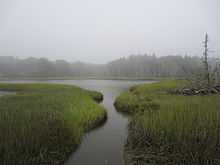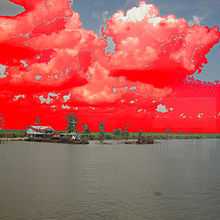Aviva Rahmani

Ecological artist Aviva Rahmani’s public and ecological art projects have involved collaborative interdisciplinary community teams with scientists, planners, environmentalists and other artists.[1][2][3][4] Her projects range from complete landscape restorations to museum venues that reference painting, sound and photography.[5][6]
Early influences on her work include her interdisciplinary Classical studies at NYU, engagement in activism, as with the Bread and Puppet Theatre, her work in city planning in San Diego County in the 1980s and Vinalhaven Island, Maine in the 1990s, and the merging of science with aesthetics.[7][8]
Education
Rahmani attended the Cooper Union School of Art and Architecture, and got her MA from the California Institute of the Arts, Valencia, California on a scholarship and stipend to work with Allan Kaprow and Morton Sobotnick, receiving a double degree in multi-media and electronic music. Rahmani has taught, lectured and performed internationally, and is the recipient of numerous grants and fellowships including two from the Nancy H. Gray Foundation for Art in the Environment in 1999 and 2000. More recently, Rahmani concurrently studied for a GIS certificate at Lehman College, CUNY, while finishing a dissertation at Plymouth University, UK.

Bio
Rahmani's background in performance and conceptual art begin with her founding and directing the performance group the American Ritual Theatre (1968- 1971).[9] In 1971, she collaborated with Judy Chicago, Suzanne Lacy, and Sandi Orgel on Ablutions, now considered a groundbreaking feminist performance work on rape (Chicago, Judy Through the Flower).
In 1999, Rahmani was a founding member of the Eco-art Dialog, an international collective of ecological art practitioners.[10]
Rahmani has received numerous grants and fellowships including two from the Nancy H. Gray Foundation for Art in the Environment and a 2009 award for her work on water from the Arts and Healing Network.[11]
Work
Rahmani has performed and exhibited work at numerous venues, including the Hudson River Museum, Exit Art, and the Cincinnati Contemporary Arts Center (Ecovention, exhibition) in Ohio.
One of Rahmani's best known works is Ghost Nets 1990-2000 (Tallmer, Kagan, Carruthers, Genocchio), which includes her original theories of environmental restoration and trigger point theory. In 2012, she applied trigger point theory and the "Gulf to Gulf" webcasts to "Fish Story Memphis," a multi-part public art project designed for “Memphis Social,” curated by Tom McGlynn (2013) (Memphis is the Center of the World).
In 2006, Rahmani initiated a series of podcasts, "Virtual Cities and Oceans of If", which segued into webcasts on climate change. She is currently an Affiliate with the Institute of Arctic and Alpine Research at the University of Colorado Boulder, Colorado (UCB), where she has been collaborating with the Director, James White since 2007[12] on, "Gulf to Gulf," a series of webcasts on global warming with other scientists, artists and thinkers.[13] Their first collaborative work premiered with Cultura21 in the Joseph Beuys Pavilion of the 2007 Venice Biennale. In 2009, Rahmani served as a formal observer for University of Colorado Boulder at the COP15 and blogged about her experience for High Tide, an arts collective based in Liverpool, UK.[14]
Rahmani's current work reflects her interest in the application of mapping analysis,[15] to "explore potential solutions for urban and rural water degradation in large landscapes."[16]
Rahmani's recent work also uses the internet "to perform residencies without the international travel that spews jet fuel over the earth's waters."[17] Virtual Cities and Oceans of If and the ongoing Virtual Concerts address global warming and geo-political conflicts by demonstrating, analyzing and interpreting the local impact of global warming at international real world sites.[18]
See also
References
- ↑ Ingram, Mrill (July–August 2012). "Sculpting Solutions". Environment Magazine.
- ↑ Love, Barbara J. and Cott, Nancy F. (2006). Feminists Who Changed America, 1963-1975. Chicago: University of Illinois Press.
- ↑ Women's Environmental Artists Directory. "Aviva Rahmani". WEAD. Retrieved 2 February 2014.
- ↑ Ernest, Dagney (October 23, 2010). "Rahmani opens, premiers in New York". The Herald Gazette.
- ↑ Carruthers, Beth. "Mapping the Terrain of Contemporary EcoART Practice and Collaboration". Green Museum. Retrieved 2006.
- ↑ Garret, Ian (2010). "Desecration/ Resurrection New Video Work by Aviva Rahmani". CSPA Quarterly. Summer 2010: 28.
- ↑ Kagan, Sacha (2011). Art and Sustainability: Connecting Patterns for a Culture of Complexity. Bielefeld, Germany: Transcript Verlag.
- ↑ Boettger, Suzaan (2008). "Global Warnings". Art in America. June/July 2008: 161, 206.
- ↑ (Love, Jones, Welton 1969, Blaze)
- ↑ http://weadartists.org/changing-aesthetics-creating-teams-3 Israel Forum for Ecological Art
- ↑ Lippard, Lucy (2014). Undermining. New Press.
- ↑ Denson, Roger (2012). "Nomad". Huffington Post.
- ↑ (Boettger,NY Times, Lippard, Weather Report)
- ↑ Center for Sustainable Practice in the Arts
- ↑ Rahmani, Aviva (2012). "Mapping Trigger Point Theory as Aesthetic Activism". Parsons Journal for Information Mapping IV (1). Retrieved 19 April 2014.
- ↑ Genocchio, Benjamin (May 20, 2007). "Digging In to Nurture Nature". New York Times.
- ↑ Boetzkes, Amanda (2010). At the Limit of Form: The Ethics of Contemporary Earth Art. University of Minnesota Press.
- ↑ Lippard, Lucy (2007). Weather Report. Boulder, Colorado: Boulder Museum of Contemporary Art.